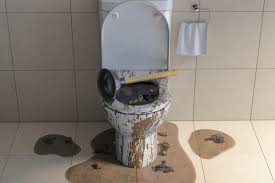A toilet that doesn’t flush properly can be a frustrating and inconvenient problem. Whether it’s a weak flush, incomplete drainage, or constant clogging, understanding the root cause is essential to fixing the issue. In this article, we’ll explore the most common reasons why your toilet may not be flushing properly and provide step-by-step solutions to get it working smoothly again.Here are some of the most common causes of a toilet not flushing properly:
- Clogged Drain or Trap: The most frequent culprit is a blockage in the toilet’s drain or trap. Items like excessive toilet paper, sanitary products, or foreign objects can obstruct the flow of water.
- Low Water Level in the Tank: If the water level in the tank is too low, there won’t be enough force to create a strong flush. This can be due to a faulty fill valve or an improperly adjusted float.
- Mineral Buildup in Rim Jets: Over time, minerals from hard water can clog the small holes under the toilet rim, reducing the water flow during a flush.
- Faulty Flapper or Flush Valve: A worn-out flapper or flush valve can prevent the tank from emptying completely, resulting in a weak flush.
- Vent Pipe Blockage: The plumbing vent pipe allows air to enter the system, ensuring proper drainage. If it’s blocked, the toilet may flush slowly or incompletely.
Now, let’s dive deeper into each of these issues and how to address them.1. Clogged Drain or TrapIf your toilet is not flushing properly, the first thing to check is whether there’s a clog. Here’s how to tackle it:
- Use a plunger to try and dislodge the blockage. Ensure a tight seal around the drain and push firmly several times.
- If the plunger doesn’t work, try a toilet auger (also called a closet auger) to reach deeper into the drain.
- Avoid using chemical drain cleaners, as they can damage your pipes over time.
2. Low Water Level in the Tank
If the water level in the tank is below the marked line, adjust the float or replace the fill valve:
- Locate the fill valve and float assembly in the tank.
- Adjust the float to raise the water level to about an inch below the overflow tube.
- If adjusting doesn’t help, consider replacing the fill valve.
3. Mineral Buildup in Rim JetsHard water deposits can block the rim jets, weakening the flush. To clean them:
- Turn off the water supply and flush the toilet to empty the tank.
- Use a small mirror to inspect the rim jets under the toilet bowl.
- Soak a cloth in vinegar and place it over the rim jets for a few hours to dissolve the buildup.
- Scrub gently with a small brush if necessary.
4. Faulty Flapper or Flush ValveA damaged flapper or flush valve can prevent the tank from emptying fully. Here’s how to fix it:
- Inspect the flapper for cracks or warping. If damaged, replace it with a new one.
- Check the flush valve for leaks or obstructions. Clean or replace it if needed.
5. Vent Pipe BlockageIf other solutions don’t work, the vent pipe might be blocked. This is a more complex issue and may require professional help. However, you can try:
- Locate the vent pipe on your roof (use caution when accessing it).
- Use a plumber’s snake or hose to clear any debris.
Preventive MeasuresTo avoid future flushing problems, follow these tips:
- Avoid flushing non-flushable items like wipes, cotton balls, or feminine hygiene products.
- Regularly clean the toilet bowl and rim jets to prevent mineral buildup.
- Check the tank components periodically for wear and tear.
By identifying the cause of your toilet not flushing properly and applying the right solution, you can restore its functionality and avoid costly repairs. If the problem persists, don’t hesitate to call a professional plumber for assistance.

